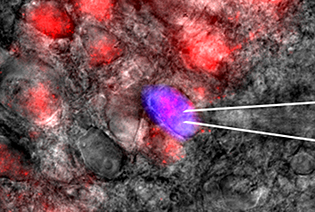New Methods
New Tool Enables Studies of Brain Structure and Function
NIEHS Researchers Developed Genetically Modified Mouse Lines to Help Identify Brain-Cell Types

PATRICIA JENSEN, NIEHS
Tool identifies individual brain cells. This micrograph displays brain cells, from one of Patricia Jensen’s new mouse lines, that express hM3Dq when activated by the agent clozapine N-oxide. In the color version of this image, the cells appear red as a result of the fluorescent protein mCherry, which is co-expressed with hM3Dq. Electrodes (white lines) are used to measure the cellular activity of a cell expressing hM3Dq-mCherry (blue dye indicates the cell being measured).
Researchers at the National Institute of Environmental Health Sciences (NIEHS) recently designed genetically modified mice that will help neurobiologists address one of the most fundamental questions in brain research: What are the different cell types in the brain, and what are their functions? The new mouse lines will let scientists identify specific populations of brain cells and determine how they control behavior. The findings will advance our understanding of neurological disorders such as Alzheimer disease, drug addiction, and depression.
It took about six years to develop and characterize the seven mouse lines, said NIEHS scientist Patricia Jensen, who is the corresponding author of the article that appeared recently in the journal Cell Reports (Cell Rep 15:2563–2573, 2016) and of a companion paper published in 2015 in the journal Development (Development 142:4385–4393, 2015).
Identifying distinct cell populations
The mouse lines allow researchers to identify distinct populations of brain cells defined by the expression of different genes during development, determine where these populations are located, and investigate their function.
The 2015 paper described mouse lines in which fluorescent proteins were used to label and visualize cells. The mouse lines described in the 2016 article allow researchers to noninvasively increase the activity of cells and observe the behavioral and physiological effects in freely moving animals. This control of cell activity is achieved by the expression of a laboratory-created mutated cell-surface receptor hM3Dq.
Developed by Bryan Roth at the University of North Carolina at Chapel Hill, hM3Dq is most often introduced into brain cells by injection with engineered viruses. But the viral-injection procedure has drawbacks, said NIEHS staff scientist Nicholas Plummer, who shared first authorship on the Cell Reports paper with postdoctoral fellow Natale Sciolino.

PHOTOS BY: STEVE MCCAW, NIEHS
NIEHS researchers designed genetically modified mice that will help neurobiologists determine brain-cell types and their functions. Left to right: Patricia Jensen, Nicholas Plummer and Natale Sciolino.
“Using viruses limits you to examining fairly compact populations of cells,” Plummer said. “With our mouse lines, we can label and control the activity of widely dispersed cells, and we can activate them any time during development.”
Current research
The mouse lines will help researchers answer key questions about developmental and functional diversity within the noradrenergic system—the neurons that use the neurotransmitter norepinephrine, also called noradrenaline. The noradrenergic system is disrupted in several conditions such as anxiety disorders, depression, Alzheimer disease, Parkinson disease, and drug addiction.
“For the first time, we’ll be able to manipulate small subsets of these neurons and ask which ones are important for anxiety-type or impulsive behaviors,” Sciolino explained.
Although Jensen’s group is studying the nervous system, the mouse lines may also be used to investigate almost any type of cell, including pancreatic beta cells and hepatocytes.
“The system can be used in virtually any cell that has the Gq-coupled signaling pathway,” Jensen said.
For more NIEHS research news, check out the online NIEHS Environmental Factor newsletter at http://www.niehs.nih.gov/news/newsletter/2016/7/.
This page was last updated on Wednesday, April 13, 2022
